On Wednesday, five families sat amongst nearly 15 others for a formal meeting of a committee set up to discuss an upcoming academic session, in tents located in Naya Basti, Boudh, Kathmandu. The locality derives its name from the 1,500-year-old Boudanath stupa, located not very far from the tents.
As many as 4,98,697 households were entirely destroyed, and another 2,56,617 partially destroyed, when the magnitude 7.8 earthquake struck Nepal on April 25 last year. As much as $4.1 billion was pledged, and about $2 billion has been received by Nepal’s National Reconstruction Authority (NRA).
Nearly a year later, just 641 people have received reconstruction grants for homes. They all belong to Lamidanda and Laduk Village Development Committees in Dolakha district, who received Nepali Rs 50,000 as first instalment of an eventual grant of NRs 2,00,000. The five families of Naya Basti , who met to discuss their children’s school on Wednesday, were not among the 641 beneficiaries.
The NRA was constituted in December last year and has seen two chiefs in five months, while the latest is facing corruption charges.
![nepal, nepal earthquake, nepal relief, nepal earthquake relief, earthquake relief nepal, nepal news, nepal photos, nepal 2015 earthquake, 2015 nepal earthquake, nepal earthquake 2015, nepal news, world news]()
The camp in Naya Basti, Kathmandu, has more than 60 families living in tents; just 641 people have received reconstruction grants for homes, all from Lamidanda, Laduk Village Development Committees in Dolakha district.
NRA spokesperson Ram Prasad Thapaliya says, “First, we undertake a survey of houses through engineers — that’s still ongoing. The approved names are then sent to the Registration Department, which takes a look and sends them to Central Level Project Implementation Units of the Ministry of Federal Affairs and Local Development. The ministry then sends the list to the NRA, which takes a call on its approval, and relays back the information,” Thapaliya says. “It is the proper method.”
According to Oxfam, the long-drawn procedure means most of the over six lakh displaced families are still living in temporary or unsafe arrangements, and at least 40,000 families have no land documentation to begin with. Just a few kilometres from Naya Basti, the Chuchepati camp has over 450 tents.
Those living in tents say their relatives will flood back to these temporary quarters when monsoon arrives, afraid that the loose mud from last year’s quake will slide down in their villages. Besides, back home, apart from homes, even schools and hospitals still lie crumbled.
The Naya Basti camp has more than 60 families living in tents. Most of them belong to Sindhupalchok district, 110 km from Kathmandu. Barring a couple of residents, they are all “distant relatives”, within the Sherpa community.
In the year since the tents came up on the land, the owner of the land has served them three notices to evict. But the worry topmost on their minds is their children’s education, and the subject of their meeting today is the crowded local school their children attend. Finally, it is decided that the children should continue at the same school as it is “too late” to do anything. So on Monday, the anniversary of the quake, the children will return to school.
Stories of survival and struggle of five residents of the Naya Basti camp:
Laxman Sherpa
The 26-year-old worked as a taxi driver in Khokundol in Sindhupalchok, about 110 km from Kathmandu. When the quake struck, he, his wife and a year-old daughter, along with six others, had been out in the mountains looking for a herb known locally as a magic drug for “strengthening immunity”. The tremor flatted homes in Khokundol, and Laxman wonders now if their trip to the Himalayas was what saved his family.
Still, Laxman says, his life could do with a bit of magic. The most valuable objects in his tent are a wooden cupboard placed at the front, a gas stove and a sewing machine lying at the back.
![nepal, nepal earthquake, nepal relief, nepal earthquake relief, earthquake relief nepal, nepal news, nepal photos, nepal 2015 earthquake, 2015 nepal earthquake, nepal earthquake 2015, nepal news, world news]()
A month after the quake, conditions in his village worsened, leaving his daughter sick. They have been at the camp since.
“We could retrieve only the gas stove and the wooden cupboard from the rubble of our house. The rest was all rendered useless,” he says.
An NGO donated them the sewing machine, so that they could eke out a living. However, since no one in the family knows how to sew, they have little use for it.
A stack of quilts and clothes sits in one corner, while other objects lie around the place. Summer has come to Kathmandu, but there is no place to keep the woollens.
Laxman says he received Nepali Rs 25,000 each from two separate NGOs, one of them Japanese. However, within four months of the quake, all the money had got over. So in September last year, Laxman sold off the family’s SUV, which he drove around as a taxi to earn a living.
“I have been looking for jobs, but haven’t been lucky. People don’t trust an outsider (since he is not originally from Kathmandu) easily,” he says, adding that the whole family is now scattered across the country, similarly looking for jobs.
Every so often, Laxman visits his ancestral village, to ask for help from the remaining relatives there, the only people he can still turn to.
Occasionally, his mind returns to that day in April. They had been trekking for three days in the Himalayas, and if they had found the prized yartsa gunbu — believed by locals to be an aphrodisiac, and to help treat several diseases, including cancer —they could have turned their fortunes around. The herb has become so scarce that the yartsa gunbu plucking community takes a trip only once in three years to the hills now to look for it.
“A kilo of dried yartsa gunbu fetches Nepali Rs 7 lakh (INR Rs 4.37 lakh),” says Laxman. “Often, we crossed into China looking for it as it has become so rare here,” says his wife Sabina, waving away mosquitoes hovering around their sleeping daughter Sona.
Among those who barely managed to escape the quake were Laxman’s mother and a nephew. Immediately after, the taxi work nosedived, and there was little food to go around, or the money to buy it.
In May 2015, as health conditions in Khokundol worsened, Sona contracted pneumonia. It was then that Laxman decided to move to Kathmandu, along with Sabina, Sona and two of Sabina’s sisters, aged 14 and 15. They obtained tents which were being distributed by NGOs, and lived for a while on the food provided by volunteers. The last NGO came with food till about four months ago.
A fortnight ago, Laxman says, he had his first good news in a year. He got a job, even if for a brief while. “A businessman hired me to drive a truck to transport cargo. I was paid NRs 5,000. I am hopeful I might be hired again.”
Nami Sherpa
When one by one, the others affected by the quake in their village Tatopani in Sindhupalchok left, Nami Sherpa, 31, and her family hung back. “We were confident we wouldn’t have to move out. Elders told us how they had braved a similar earthquake in 1934,” she says. “We also thought that as the others moved out, there would be more resources for us.”
However, aid was slow in coming, and little at that. “As people started leaving, whatever aid workers came our way went elsewhere too, seeing the deserted villages,” she says.
So two months after the quake, Nami, her husband Chhewang Sherpa, two sons, and uncles and cousins, moved to Kathmandu.
Life has been a struggle since, she says, particularly when the “second earthquake” hit, talking about the unofficial embargo on fuel from India. “The price of an LPG cylinder was already high. The blockade from India made it worse. From NRs 1,400 before the earthquake, the cost went up to NRs 8,000-9,000. It is now sold for about NRs 2,500 and we don’t know when it might go back to the pre-quake figures,” she says.
The plastic sheet walls inside her tent are all blue. She tries to keep things organised, as best as she can. In one corner is the kitchen, her father’s bed occupies another, while the others in the family sleep in another corner. Of the family members that moved into the tents, only Nami, Chhewang, their children, and his parents now remain.
![nepal, nepal earthquake, nepal relief, nepal earthquake relief, earthquake relief nepal, nepal news, nepal photos, nepal 2015 earthquake, 2015 nepal earthquake, nepal earthquake 2015, nepal news, world news]()
She tries to ensure her two sons, 13 and 7, are well-fed, from regular eggs to thick soupy chicken for dinner.
Standing out in the cramped surroundings is a stack of egg crates. “My children are growing up,” Nami explains.
Most nights for dinner, she serves thick soupy chicken, which Lopsang, her younger son, 7, devours from a bowl. However, she is not sure how long she can keep up the meals given that they are on the last leg of their savings of NRs 3 lakh.
Nami also shivers thinking about what a close shave Lopsang and her elder son Karma, 13, had on the day of the quake. The brothers were by the Bhote Koshi river washing their clothes when they felt the ground shake. They laughed initially, but the rumble soon scared them, and they ran back home.
“Soon after they returned, water came crashing down and flooded the area where they were. Water had been released from the Bhote Koshi dam after the earthquake,” says Nami.
Her husband Chhewang led a Truckers’ Association at the Chinese border and helped them leave. He had been away at the time attending a prayer ceremony.
Nami remembers that she and Chhewang had moved to Tatopani from Pangshirpu village for “a better life”. “We had sold our yak, two dozen dzos (a yak hybrid), and about a dozen goats for a better start.”
“We lived on rent in Tatopani and it was that house which collapsed. The owner’s aunt screamed for help for a good 15 minutes before she was rescued,” she recalls.
Now her priority are her children. Nami is worried that Samata, the low-cost and heavily subsidised private school they go to, is crowded with over 1,900 students. The admission was free and the fee is only NRs 100 per month per child. NGOs provide the children schoolbooks, shoes, uniforms, though her sons couldn’t get the same as they were initially enrolled in Shram, a government school, which had NRs 3,500 admission fee and NRs 150 monthly fee.
She thinks of returning to her village sometimes. But her sons’ education stops her. “The next session is about to start and I can’t think of leaving.”
Lopsang Sherpa
The family of seven shares a tent, with a double-bed mattress serving as a combined bed. The seven include Lopsang, his wife and seven-year-old son, his sister and her two daughters, and his sister-in-law.
Utensils are neatly stacked by a gas stove, as a lone solar bulb dangles overhead.
The odd family dynamics stopped worrying Lopsang, 33, long back. They moved in just 15 days after the quake, after their village Pakip in Sindhupalchok was hit by the quake.
![nepal, nepal earthquake, nepal relief, nepal earthquake relief, earthquake relief nepal, nepal news, nepal photos, nepal 2015 earthquake, 2015 nepal earthquake, nepal earthquake 2015, nepal news, world news]()
Earlier, he would buy clothes from China to sell in markets, including in Delhi.
“We received NRs 15,000 from the government and another NRs 15,000 from an NGO,” Lopsang says. The money didn’t last long. The production on their 16 ropani (1 Indian bigah) agricultural land has also been steadily falling, though it is their only source of income now. “The land supports a large family and the savings are stretched,” Lopsang says.
Before the quake, the 33-year-old was a small-time businessman. “By showing our Nepali identity cards, we were allowed to enter about 10 km into China to purchase clothes,” he says. “We would sell these goods in Nepal, and earlier, even in Majnu ka Tila in New Delhi.”
Most days, his destination used to be Liping, one of those towns now in China where, Lopsang says, people are ethnically Nepali. One of his sisters was married into the town too, he says. The tremors flattened Liping too.
Lopsang believes the earthquake also gave China the opportunity it had long been looking for to crack down on the people in Liping, who are Tibetan Buddhists and hence followers of the Dalai Lama. “My sister told me Chinese authorities asked everyone to move several kilometres inside the border on the Nepal side. The border was then sealed. Liping has become a ghost town. I hear they intermittently reopen the border for a few days, but my business is dead. My sister has gone far away too.”
Lopsang ponders about going back to Pakip, but the thought of the coming monsoon makes him nervous. “The land has loosened after the earthquake and, during monsoons, Sindhupalchok will witness landslides. The conditions are already terrible.”
Yes, some of his family members have gone back home, leaving the tents. But, Lopsang says, “They will come back.”
Sapna Khatri
All they have left are the mattresses and quilts in the small tent that the six of them share. However, what weighs on Rajendra Poudel’s mind most is security. “We have had our solar lights stolen twice. And people also steal these mattresses or quilts,” he says.
Poudel shares the tent with his three nieces — Renuka Karki, 14, Devika Kharki, 12, Sapna Khatri, 17 — their brother Rohit and Sapna’s seven-month-old son.
![nepal, nepal earthquake, nepal relief, nepal earthquake relief, earthquake relief nepal, nepal news, nepal photos, nepal 2015 earthquake, 2015 nepal earthquake, nepal earthquake 2015, nepal news, world news]()
Their lights got stolen, and family is worried same may happen to quilts.
Sapna’s parents also lived in the tent till a week ago, but have now gone back to their village Daragaon, Sindhupalchok, to tend to the fields, the family’s only source of income. As her sisters go to school, Sapna stays back to look after her son. “He still doesn’t eat biscuit paste well, so I have to feed him water after every spoon,” she says.
When the earthquake came, Sapna was tilling their field, while a scared Renuka and Devika first rushed indoors. Elders yelled and chased them out, says Sapna. “The house collapsed a few seconds later.”
Sapna has another brother, just 19 months old, who is currently with her parents in the village.
“We could just retrieve a few clothes from the rubble when the quake came. Everything else was buried,” Sapna says. Her father-in-law, aged 70, suffered from broken bones as he got buried under their crumbled house.
Renuka says they don’t have much to do at the camp. “We just go to school, eat, sleep, or check each other’s hair for lice.”
Talking about her parents who are also rebuilding their house, Sapna sighs, “Earlier, the house was just a big hall and they had initiated building of more rooms for the family. But we never got to live in the rooms. They collapsed.”
Mingmar Sherpa
He lives in a tent with his wife and an infant son, but Mingmar says he couldn’t be happier.
The son, Tenzin Somgpo Sherpa, now three months old, was born at the camp. “This is his home,” wife Lamu says. “The doctors too said that we should keep him here, and not take him back to the village.”
However, that’s only part of the reason for them not minding living in the tent. As Lamu adds, laughing, since the quake, Mingmar hasn’t needed to work. “We were given NRs 9,600 by Myanmar and about NRs 20,000 by our relatives,” she says.
“Each day, I wash Tenzin’s clothes, massage him with mustard oil, change his clothes at least twice daily,” she says. Around her lies a UNICEF-marked bucket, among other things. “It had a towel, toothpaste, toothbrush, soap, nail-cutter, comb and other hygiene products,” she says.
Above her, the tarpaulin is marked USAID.
In contrast, the family’s life back home in Selangkatti in Sindhupalchok was never easy. “I didn’t own any land but would work on fields owned by my relatives,” says Mingmar. “I had a hand-to-mouth existence, though there were people around who supported us. I studied till Class IV and then dropped out.”
He claims that while he worked hard in the farms, the yield was never enough to put money in the pocket. Mingmar and Lamu, along with Mingmar’s brother and his wife, as well as their parents, tilled the land, measuring a little less than 1 bigha, together. The youngest brother went to school.
![nepal, nepal earthquake, nepal relief, nepal earthquake relief, earthquake relief nepal, nepal news, nepal photos, nepal 2015 earthquake, 2015 nepal earthquake, nepal earthquake 2015, nepal news, world news]()
Their baby was born at the camp, and the aid has kept flowing.
“I even took a certificate course to become an electrician, but it didn’t help,” Mingmar says.
After the quake brought down all the three houses the extended family lived in, they shifted to Kathmandu. A few months ago, they went back, except for Mingmar, Lamu and Tenzin.
While content, Lamu is a bit worried. Tenzin “isn’t laughing much” as he has diarrhoea for the past few days. Suspended above him is a ball, an earthquake-victim family card, and a pacifier.
Quake, and after
* 8,891 Number of deaths
* 22,309 Number of injured
* 6,02,257 Number of houses destroyed
* 6,430 Number of government buildings damaged
* Nearly 1 million Number of children left with no school
* 3.7 million Number of people receiving humanitarian aid
* Less than 5% Percentage of homes rebuilt so far
* $6.6 billion Total estimated cost for reconstruction
* $4.1 billion Amount pledged so far in donations
* $308,880 Total funding Nepal has offered for reconstructing homes
* 641 Number of Nepalese families who have received reconstruction funding
![]()
 Adil’s father and younger brother; The minor’s house in Dhori is locked, the family left a few days after the arrest. Prashant Pandey
Adil’s father and younger brother; The minor’s house in Dhori is locked, the family left a few days after the arrest. Prashant Pandey
![]() Days after Bokaro violence, Hindu outfits blame police
Days after Bokaro violence, Hindu outfits blame police![]() Jharkhand: 25 held for mob attack on police station
Jharkhand: 25 held for mob attack on police station![]() Youth held for ‘objectionable’ FB post against Azam Khan
Youth held for ‘objectionable’ FB post against Azam Khan![]() Police raids Giriraj Singh's home to arrest him for hate remarks
Police raids Giriraj Singh's home to arrest him for hate remarks![]() Jama Masjid attack: Doubts surface over murdered Qateel’s ‘confession’ to Delhi Police
Jama Masjid attack: Doubts surface over murdered Qateel’s ‘confession’ to Delhi Police![]() Girlfriend's post on Facebook lands man in jail
Girlfriend's post on Facebook lands man in jail






 A day in the lifeof Vinod Sonkar , 37, fruit vendor selling fruits just in front of collapsed flyover in Kolkata. Express photo by Partha Paul
A day in the lifeof Vinod Sonkar , 37, fruit vendor selling fruits just in front of collapsed flyover in Kolkata. Express photo by Partha Paul
 Almost every protest march during the recent unrest at JNU began and ended with slogans of ‘Jai Bhim’, ‘Lal Salaam’. (Source: Express Photo by Tashi Tobgyal)
Almost every protest march during the recent unrest at JNU began and ended with slogans of ‘Jai Bhim’, ‘Lal Salaam’. (Source: Express Photo by Tashi Tobgyal)
 At the University of Hyderabad, Ambedkar is everwhere — on walls, cupboards, stray rocks and boulders, even in songs such as Anduko dandalu Baba Ambedkara, an ode to Ambedkar in Telugu that is played in most hostel rooms on the campus. (Source: Express photo by Harsha Vadlamani)
At the University of Hyderabad, Ambedkar is everwhere — on walls, cupboards, stray rocks and boulders, even in songs such as Anduko dandalu Baba Ambedkara, an ode to Ambedkar in Telugu that is played in most hostel rooms on the campus. (Source: Express photo by Harsha Vadlamani)
 In January, students of Pune’s Film and Telvision Institute of India sat on a day-long hunger strike to protest against the suspension of five Dalit students, including Rohith Vemula, at the University of Hyderabad. (Source: Express Photo by Arul Horizon)
In January, students of Pune’s Film and Telvision Institute of India sat on a day-long hunger strike to protest against the suspension of five Dalit students, including Rohith Vemula, at the University of Hyderabad. (Source: Express Photo by Arul Horizon)
 Similar protests were also held at Mumbai University’s Kalina campus. (Source: Express photo)
Similar protests were also held at Mumbai University’s Kalina campus. (Source: Express photo)
 Che Guevara, Ambedkar, Hugo Chavez… Hostel walls in JNU have space for both Dalit and Left ideologies. (Source: Express photo by Aranya Shankar)
Che Guevara, Ambedkar, Hugo Chavez… Hostel walls in JNU have space for both Dalit and Left ideologies. (Source: Express photo by Aranya Shankar)
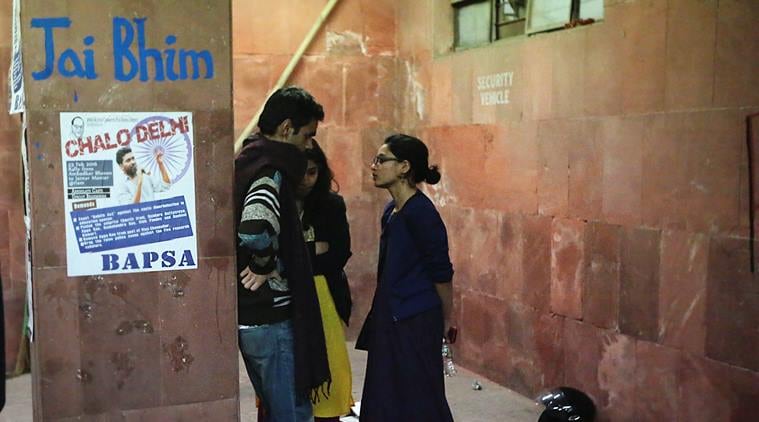 Ambedkar’s works, are mandatory reading for every BAPSA member. Wall graffiti at JNU campus. (Source: Express Photo by Tashi Tobgyal)
Ambedkar’s works, are mandatory reading for every BAPSA member. Wall graffiti at JNU campus. (Source: Express Photo by Tashi Tobgyal)
 A demonstrator shouts slogans and waves the Indian national flag as she takes part in a protest demanding the release of Kanhaiya Kumar, Jawaharlal Nehru University (JNU) student union leader accused of
A demonstrator shouts slogans and waves the Indian national flag as she takes part in a protest demanding the release of Kanhaiya Kumar, Jawaharlal Nehru University (JNU) student union leader accused of  Illustration: C R Sasikumar
Illustration: C R Sasikumar
















 For long, Ambedkar’s writings on caste and social exploitation were ignored by Left ideologues.
For long, Ambedkar’s writings on caste and social exploitation were ignored by Left ideologues.





 NIA officer Tanzil Ahmad was shot dead in Bijnor
NIA officer Tanzil Ahmad was shot dead in Bijnor





 Reyan’s grandfather Abdul Haq and father Shahadat say that while there was some family tension, it was not reason enough to kill someone
Reyan’s grandfather Abdul Haq and father Shahadat say that while there was some family tension, it was not reason enough to kill someone
 Accused Janu and Rehan produced in a court in connection with the murder of NIA Deputy SP Mohammad Tanzil in Moradabad. PTI Photo
Accused Janu and Rehan produced in a court in connection with the murder of NIA Deputy SP Mohammad Tanzil in Moradabad. PTI Photo
 The family of Rizwan, who works as a small-time contractor, denies the charges as does the family of Tanzeem, who, his brother Nadeem says, was preparing to leave for Saudi Arabia. PTI Photo
The family of Rizwan, who works as a small-time contractor, denies the charges as does the family of Tanzeem, who, his brother Nadeem says, was preparing to leave for Saudi Arabia. PTI Photo
 Photo for representational purpose. (Wikipedia)
Photo for representational purpose. (Wikipedia)





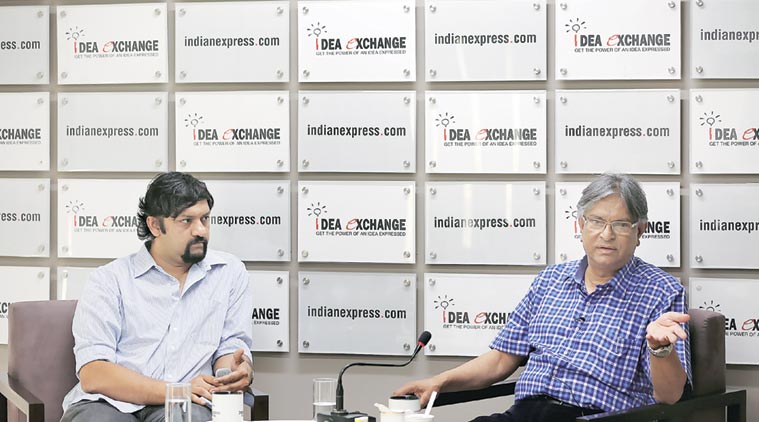 Jamia Millia Islamia University Vice-Chancellor Talat Ahmad (right) with Delhi City Editor Apurva at
Jamia Millia Islamia University Vice-Chancellor Talat Ahmad (right) with Delhi City Editor Apurva at  Following the ban, Lali’s toddy stock, at Rs 10 a mug, gets sold out immediately. (Express Photo by Prashant Ravi)
Following the ban, Lali’s toddy stock, at Rs 10 a mug, gets sold out immediately. (Express Photo by Prashant Ravi)
 Lali climbs palm trees three times a day to make fresh cuts, that help “maintain the sap flow”
Lali climbs palm trees three times a day to make fresh cuts, that help “maintain the sap flow”
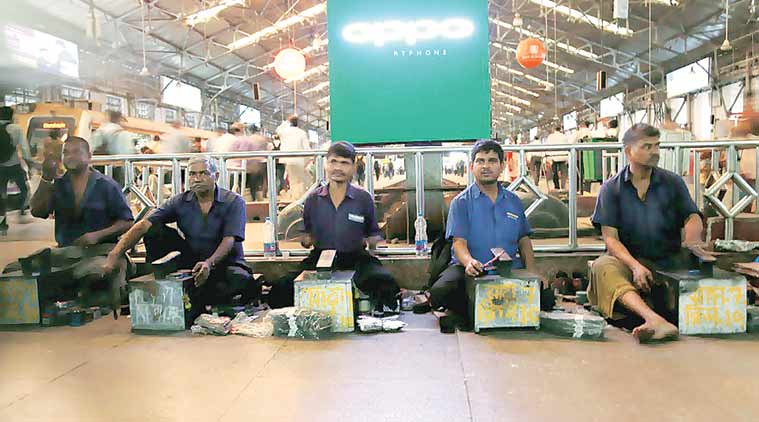 Arvind’s place at Churchgate station has been quickly taken up. (Express Photo by Abhijit Alka Anil)
Arvind’s place at Churchgate station has been quickly taken up. (Express Photo by Abhijit Alka Anil)
 The water train chugging into Latur on its fourth run Friday evening. (Express Photo by Pradip Das)
The water train chugging into Latur on its fourth run Friday evening. (Express Photo by Pradip Das)
 It takes 3 hours to fill a wagon with 50,000 litres at Miraj right now. Plan is to cut this to 10 hours for 50 wagons. (Express Photo by Arul Horizon)
It takes 3 hours to fill a wagon with 50,000 litres at Miraj right now. Plan is to cut this to 10 hours for 50 wagons. (Express Photo by Arul Horizon)
 Water being filled into tankers near the Latur station. 50 rail wagons would hold water equal to 450 tankers. (Express Photo by Pradip Das)
Water being filled into tankers near the Latur station. 50 rail wagons would hold water equal to 450 tankers. (Express Photo by Pradip Das)
 Pipeline being laid at Latur railway station. The idea is to cut down time taken in use of water tankers. (Express Photo by Pradip Das)
Pipeline being laid at Latur railway station. The idea is to cut down time taken in use of water tankers. (Express Photo by Pradip Das)
 50 wagons, emptied of 25 lakh litres, at Bhilwara railway station. (Express Phot by Rohit Jain Paras)
50 wagons, emptied of 25 lakh litres, at Bhilwara railway station. (Express Phot by Rohit Jain Paras)
 India’s first water train. For 6 weeks, 6 trains carried 30 lakh litres daily. (Express Archive)
India’s first water train. For 6 weeks, 6 trains carried 30 lakh litres daily. (Express Archive)

 At her parents’ home in Kashipur. Shayara hasn’t met her two children since she left Allahabad last April. (Express Photo by Ravi Kanojia)
At her parents’ home in Kashipur. Shayara hasn’t met her two children since she left Allahabad last April. (Express Photo by Ravi Kanojia)
 The camp in Naya Basti, Kathmandu, has more than 60 families living in tents; just 641 people have received reconstruction grants for homes, all from Lamidanda, Laduk Village Development Committees in Dolakha district.
The camp in Naya Basti, Kathmandu, has more than 60 families living in tents; just 641 people have received reconstruction grants for homes, all from Lamidanda, Laduk Village Development Committees in Dolakha district.
 A month after the quake, conditions in his village worsened, leaving his daughter sick. They have been at the camp since.
A month after the quake, conditions in his village worsened, leaving his daughter sick. They have been at the camp since.
 She tries to ensure her two sons, 13 and 7, are well-fed, from regular eggs to thick soupy chicken for dinner.
She tries to ensure her two sons, 13 and 7, are well-fed, from regular eggs to thick soupy chicken for dinner.
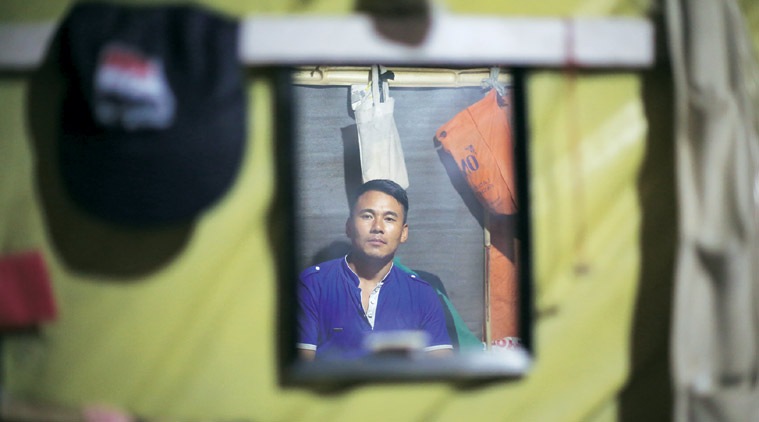 Earlier, he would buy clothes from China to sell in markets, including in Delhi.
Earlier, he would buy clothes from China to sell in markets, including in Delhi.
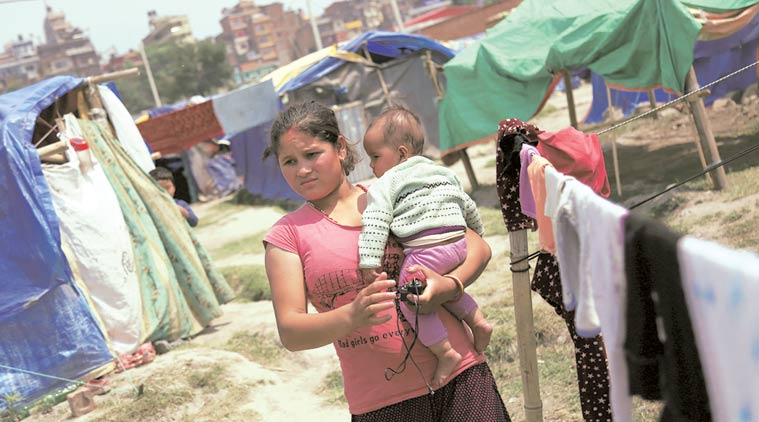 Their lights got stolen, and family is worried same may happen to quilts.
Their lights got stolen, and family is worried same may happen to quilts.
 Their baby was born at the camp, and the aid has kept flowing.
Their baby was born at the camp, and the aid has kept flowing.
 Daughter Siddiqua Ahmed says her father stopped practising law after losing the case in 1985 to Shah Bano, “because he took it as an insult”. (Express Photo by Milind Ghatwai)
Daughter Siddiqua Ahmed says her father stopped practising law after losing the case in 1985 to Shah Bano, “because he took it as an insult”. (Express Photo by Milind Ghatwai)
 Santosh Gaikwad at work at the country’s only taxidermy centre, at Sanjay Gandhi National Park in Mumbai. He is in-charge of the centre. (Source: Express photo Vasant Prabhu)
Santosh Gaikwad at work at the country’s only taxidermy centre, at Sanjay Gandhi National Park in Mumbai. He is in-charge of the centre. (Source: Express photo Vasant Prabhu)
 Illustration: C R Sasikumar
Illustration: C R Sasikumar


 The murder of ‘Mataji’ Chand Kaur at their heavily guarded dera in Bhaini Sahib has shaken the Namdhari sect. Gurmeet Singh
The murder of ‘Mataji’ Chand Kaur at their heavily guarded dera in Bhaini Sahib has shaken the Namdhari sect. Gurmeet Singh






 The girl appeared over 60 times in three different trials in the case. (Source: Express photo by Vishal Srivastav)
The girl appeared over 60 times in three different trials in the case. (Source: Express photo by Vishal Srivastav)
















